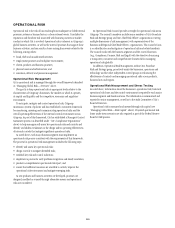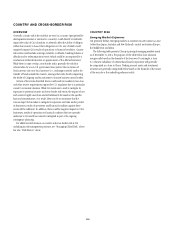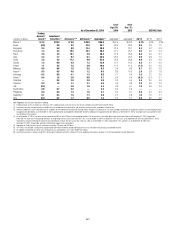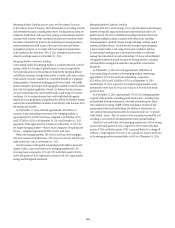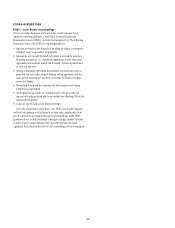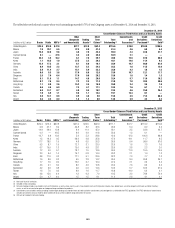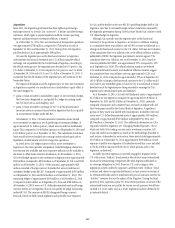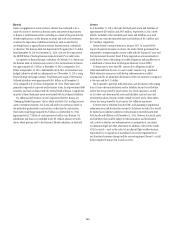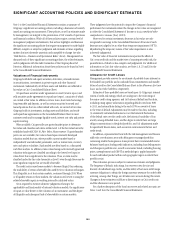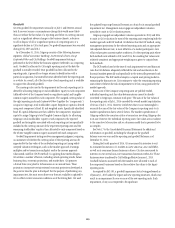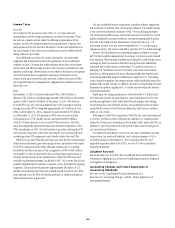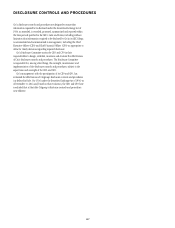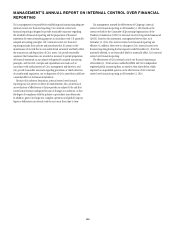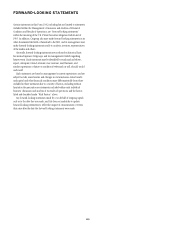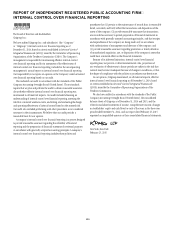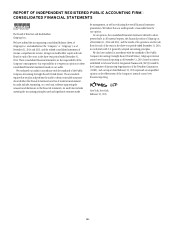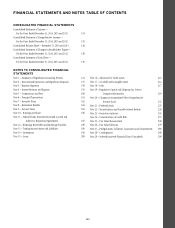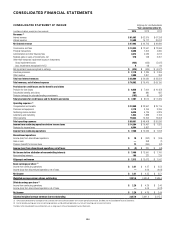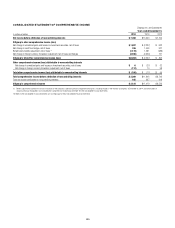Citibank 2014 Annual Report Download - page 142
Download and view the complete annual report
Please find page 142 of the 2014 Citibank annual report below. You can navigate through the pages in the report by either clicking on the pages listed below, or by using the keyword search tool below to find specific information within the annual report.125
Goodwill
Citi tests goodwill for impairment annually on July 1 and between annual
tests if an event occurs or circumstances change that would more-likely-
than-not reduce the fair value of a reporting unit below its carrying amount,
such as a significant adverse change in the business climate, a decision
to sell or dispose of all or a significant portion of a reporting unit, or a
significant decline in Citi’s stock price. No goodwill impairment was recorded
during 2014, 2013 and 2012.
As of December 31, 2014, Citigroup consists of the following business
segments: Global Consumer Banking, Institutional Clients Group,
Corporate/Other and Citi Holdings. Goodwill impairment testing is
performed at the level below the business segment (referred to as a reporting
unit). Goodwill is allocated to Citi’s eight reporting units at the date the
goodwill is initially recorded. Once goodwill has been allocated to the
reporting units, it generally no longer retains its identification with a
particular acquisition, but instead becomes identified with the reporting unit
as a whole. As a result, all of the fair value of each reporting unit is available
to support the allocated goodwill.
The carrying value used in the impairment test for each reporting unit is
derived by allocating Citigroup’s total stockholders’ equity to each component
(defined below) of the Company based on regulatory capital and tangible
common equity assessed for each component. The assigned carrying value of
the eight reporting units and Corporate/Other (together the “components”)
is equal to Citigroup’s total stockholders’ equity. Regulatory capital is derived
using each component’s Basel III risk-weighted assets. Specifically identified
Basel III capital deductions are then added to the components’ regulatory
capital to assign Citigroup’s total Tangible Common Equity. In allocating
Citigroup’s total stockholders’ equity to each component, the reported
goodwill and intangibles associated with each reporting unit are specifically
included in the carrying amount of the respective reporting units and the
remaining stockholders’ equity is then allocated to each component based on
the relative tangible common equity associated with each component.
Goodwill impairment testing involves management judgment, requiring
an assessment of whether the carrying value of the reporting unit can be
supported by the fair value of the individual reporting unit using widely
accepted valuation techniques, such as the market approach (earnings
multiples and/or transaction multiples) and/or the income approach
(discounted cash flow (DCF) method). In applying these methodologies,
Citi utilizes a number of factors, including actual operating results, future
business plans, economic projections, and market data. Citi prepares
a formal three-year plan for its businesses on an annual basis. These
projections incorporate certain external economic projections developed at
the point in time the plan is developed. For the purpose of performing any
impairment test, the most recent three-year forecast available is updated by
Citi to reflect current economic conditions as of the testing date. Citi used
the updated long-range financial forecasts as a basis for its annual goodwill
impairment test. Management may engage an independent valuation
specialist to assist in Citi’s valuation process.
Citigroup engaged an independent valuation specialist in 2013 and 2014
to assist in Citi’s valuation for most of the reporting units employing both the
market approach and DCF method. Citi believes that the DCF method, using
management projections for the selected reporting units and an appropriate
risk-adjusted discount rate, is most reflective of a market participant’s view
of fair values given current market conditions. For the reporting units where
both methods were utilized in 2013 and 2014, the resulting fair values were
relatively consistent and appropriate weighting was given to outputs from
both methods.
The DCF method used at the time of each impairment test used discount
rates that Citi believes adequately reflected the risk and uncertainty in the
financial markets generally and specifically in the internally generated cash
flow projections. The DCF method employs a capital asset pricing model in
estimating the discount rate. Citi continues to value the remaining reporting
units where it believes the risk of impairment to be low, using primarily the
market approach.
Since none of the Company’s reporting units are publicly traded,
individual reporting unit fair value determinations cannot be directly
correlated to Citigroup’s common stock price. The sum of the fair values of
the reporting units at July 1, 2014 exceeded the overall market capitalization
of Citi as of July 1, 2014. However, Citi believes that it is not meaningful to
reconcile the sum of the fair values of the Company’s reporting units to its
market capitalization due to several factors. The market capitalization of
Citigroup reflects the execution risk in a transaction involving Citigroup due
to its size. However, the individual reporting units’ fair values are not subject
to the same level of execution risk or a business model that is perceived to be
as complex.
See Note 17 to the Consolidated Financial Statements for additional
information on goodwill, including the changes in the goodwill
balance year-over-year and the reporting unit goodwill balances as of
December 31, 2014.
During the fourth quarter of 2014, Citi announced its intention to exit
its consumer businesses in 11 markets in Latin America, Asia and EMEA,
as well as its consumer finance business in Korea. Citi also announced its
intention to exit several non-core transactions businesses within ICG. These
businesses were transferred to Citi Holdings effective January 1, 2015.
Goodwill balances associated with the transfers were allocated to each of
the component businesses based on their relative fair values to the legacy
reporting units.
As required by ASC 350, a goodwill impairment test is being performed as
of January 1, 2015 under the legacy and new reporting structures, which may
result in an impairment for one or more of the new reporting units. Such
impairment, if any, is not expected to be significant.


